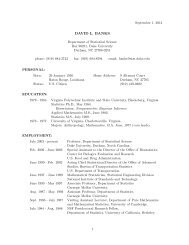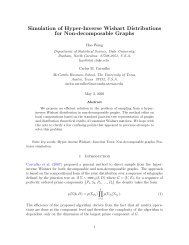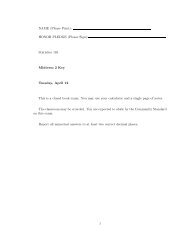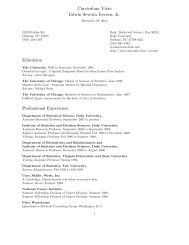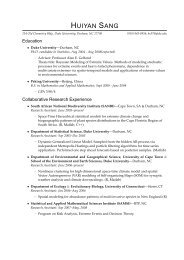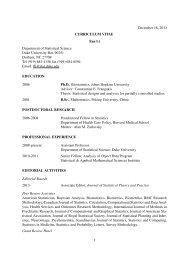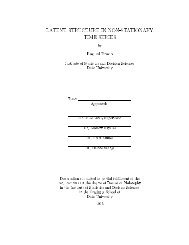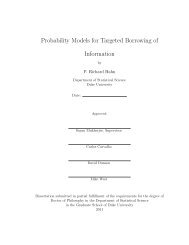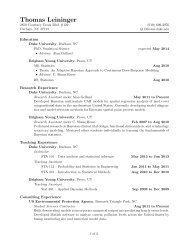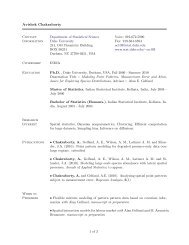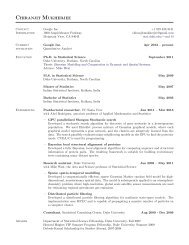Sparse Seemingly Unrelated Regression Modelling - Department of ...
Sparse Seemingly Unrelated Regression Modelling - Department of ...
Sparse Seemingly Unrelated Regression Modelling - Department of ...
You also want an ePaper? Increase the reach of your titles
YUMPU automatically turns print PDFs into web optimized ePapers that Google loves.
<strong>Sparse</strong> <strong>Seemingly</strong> <strong>Unrelated</strong> <strong>Regression</strong> <strong>Modelling</strong>:<br />
Applications in Econometrics and Finance<br />
By HAO WANG<br />
<strong>Department</strong> <strong>of</strong> Statistical Science, Duke University,<br />
Durham, North Carolina 27708-0251, U.S.A.<br />
hao@stat.duke.edu<br />
Summary<br />
We present a sparse seemingly unrelated regression (SSUR) model to generate substantively<br />
relevant structures in the high-dimensional distributions <strong>of</strong> seemingly unrelated<br />
model (SUR) parameters. This SSUR framework includes prior specifications, posterior<br />
computations using Markov chain Monte Carlo methods, evaluations <strong>of</strong> model<br />
uncertainty, and model structure searches. Extensions <strong>of</strong> the SSUR model to dynamic<br />
models embed general structure constraints and model uncertainty in dynamic models.<br />
A simulated example illustrates the model and highlights questions regarding model<br />
uncertainty, searching, and comparison. The model is then applied to three real-world<br />
examples in macroeconomics and finance according to which its identified structures<br />
have practical significance.<br />
Some key words: Gaussian graphical model; Hyper-inverse Wishart distribution; Marginal<br />
likelihood; Markov chain Monte Carlo; Performance evaluation; Variable selection<br />
1 Introduction<br />
This article develops a sparse seemingly unrelated regression (SSUR) model with Gaussian<br />
errors; that is, a set <strong>of</strong> regressions in which both regression coefficients and error<br />
precision matrix have many zeros. Zeros in regression coefficients arise when each response<br />
possibly only depends on a subset <strong>of</strong> different predictors; zeros in a precision<br />
matrix arise when the error terms satisfy a set <strong>of</strong> conditional independence restrictions<br />
consistent with an underlying graphical model (Whittaker, 1990; Lauritzen, 1996). We<br />
study and propose a fully Bayesian analysis <strong>of</strong> the SSUR model, and provide effective<br />
methods for marginal likelihood computation using a specified subset <strong>of</strong> variables and<br />
a specified graphical model to structure the covariance matrix. This enables the simultaneous<br />
selections <strong>of</strong> variables and the covariance matrix as well as comparison <strong>of</strong><br />
posterior inferences with respect to subsets and conditional independence structures.<br />
<strong>Seemingly</strong> unrelated regression models (SUR) are frequently used in econometric, financial<br />
and sociological modelling (Zellner, 1962, 1971; Box & Tiao, 1973; Srivastava & Giles,<br />
1987). Recent advances in Markov chain Monte Carlo methods enable Bayesian analyses<br />
<strong>of</strong> more complex variations <strong>of</strong> the SUR model (Chib & Greenberg, 1995; Smith & Kohn,<br />
2000; Griffiths, 2001). We build on prior work in non-sparse Bayesian SUR model analysis<br />
and develop MCMC methods for model fitting and computation for the sparse SUR
model. We note that the synthesis <strong>of</strong> sparse regression models and sparse covariance<br />
matrix models has been considered by Cripps et al. (2003) and George et al. (2008),<br />
though with a different practical focus than the SUR model. These analysis indirectly<br />
model parsimonious covariance matrices on their re-parameterised forms; they address<br />
model uncertainty by computing posterior model probabilities without attempting to<br />
calculate the marginal likelihood by introducing a model indicator into a list <strong>of</strong> unknown<br />
parameters. To use these methods, one must specify all competing models, and carefully<br />
choose some tuning parameters to ensure that the chain mixes well in model space.<br />
We directly model the sparse inverse covariance matrix through use <strong>of</strong> conjugate priors;<br />
this leads to an efficient posterior sampling (Carvalho et al., 2007) with marginal likelihood<br />
calculated using Monte Carlo methods. Our examples show that these marginal<br />
likelihood approximations are adequate and useful in assessing alternative models.<br />
In the context <strong>of</strong> dynamic SUR models, the graphical modelling <strong>of</strong> the covariance<br />
matrix <strong>of</strong> multivariate data appears in Carvalho & West (2007a,b) and Wang et al.<br />
(2009). Our extension <strong>of</strong> the dynamic SSUR models generalises this earlier work on<br />
the dynamic matrix-variate graphical model; we provide a fully Bayesian inference and<br />
model comparison related to both regression coefficient linear equality constraints and<br />
error intra-dependencies in the cross-sectional structure <strong>of</strong> the time series.<br />
2 Model and priors<br />
2.1 The basic model<br />
To introduce the SSUR model, we begin with the usual SUR model. Consider p univariate<br />
dependent variables y i,t following individual regressions:<br />
y i,t = X ′ i,t β i + e i,t , t = 1, 2, · · · , T (1)<br />
where X i,t is the n i −vector <strong>of</strong> observations on n i explanatory variables with possibly<br />
a constant term for individual i at time t, β i = (β i1 , · · · , β ini ) is a n i −vector <strong>of</strong> unknown<br />
coefficients, and e i,t is a random error. Combine the model as follows: (a)<br />
y t = (y 1,t , · · · , y p,t ) ′ , the p ×1 observation vector;(b) X t = diag(X 1,t , X 2,t , · · · , X p,t ), the<br />
n × p matrix <strong>of</strong> observations on explanatory variables at time t with n = ∑ p<br />
i=1 n i; (c)<br />
β t = (β 1 ′, · · · , β′ p )′ , the n−vector <strong>of</strong> coefficients; and (d) e t = (e 1 , · · · , e p ) ′ , the p−vector<br />
<strong>of</strong> errors distributed as N(0, V ). Then the model is<br />
y t = X ′ t β t + e t , t = 1, 2, · · · , T. (2)<br />
The SUR model assumes the errors are contemporaneous correlated but not autocorrelated.<br />
In other words, let e = (e ′ 1, · · · , e ′ T )′ , the SUR model assumes cov(e) = I T ⊗ V.<br />
2.2 Variable selection in SUR<br />
<strong>Sparse</strong> regressions involve a set <strong>of</strong> higher-dimensional regressions with which one models<br />
the relationship between y i and X i for i = 1, · · · , p, and there is uncertainty about
which subset <strong>of</strong> X i to use. Brown et al. (1998) extend the variable selection <strong>of</strong> multiple<br />
regression models to multivariate regression models. However, their model assumes<br />
all responses have the same predictors, and thus must generate a subset <strong>of</strong> predictors<br />
appropriate for all responses. The SUR model is broader and employs multivariate<br />
regression as a special case.<br />
We now proceed to consider Bayesian approaches to SUR model variable selection.<br />
The variable selection problem arises when there is an unknown subset <strong>of</strong> X i with<br />
regression coefficients so small in predicting y i that it becomes preferable to ignore<br />
them. We let γ = (γ 11 , · · · , γ pnp ) index each <strong>of</strong> these 2 n possible subset choices, where<br />
γ ij = 0 or 1 according to whether β ij is small or large, respectively.<br />
The forms <strong>of</strong> prior distributions for parameters β given γ is given as β = N(m 0 , H γ ).<br />
m 0 and H γ must be specified after structuring. One convenient choice <strong>of</strong> m 0 is a zero<br />
vector. The class <strong>of</strong> H γ may take the form H γ = D γ R γ D γ , following the univariate<br />
regression form <strong>of</strong> George & McCulloch (1993). Here D γ is a n×n diagonal matrix and<br />
R γ is a correlation matrix. The element <strong>of</strong> D γ corresponding to β ij is τ ij0 when γ ij = 0<br />
and τ ij1 when γ ij = 1. Particular considerations about τ ij0 , τ ij1 and R γ are discussed<br />
by George & McCulloch (1993, 1997). One convenient choice for R is I, under which<br />
the elements <strong>of</strong> β are a priori independent. Another choice is a block diagonal matrix<br />
in which each block corresponds to the covariance matrix <strong>of</strong> the n i -vector <strong>of</strong> β i .<br />
2.3 Structured covariance matrix<br />
The role <strong>of</strong> covariance matrix V in inferring β is one <strong>of</strong> the most important features <strong>of</strong><br />
SUR models. The non-diagonality <strong>of</strong> the error covariance matrix usually entails that<br />
individual regression estimates using univariate linear model are sub-optimal; joint<br />
estimations <strong>of</strong> SUR that exploits the correlation between errors across equations may<br />
improve the level <strong>of</strong> model inference. Motivation for our work relates to the increased<br />
dimension and complexity <strong>of</strong> the error covariance matrix. In this context, the covariance<br />
matrix must be understood in terms <strong>of</strong> structure and parsimony.<br />
Substantial progress has been made on Bayesian covariance modelling by imposing<br />
structures. Structures are typically obtained by restricting the elements <strong>of</strong> a reparameterisation<br />
for V (Daniels & Pourahmadi, 2002; Smith & Kohn, 2002; Chen & Dunson,<br />
2003). Although a conditional conjugate posterior can usually be obtained on reparameterised<br />
space, the main issue in these approaches is that the induced prior on<br />
V depends on the ordering <strong>of</strong> elements. We directly and parsimoniously model V by<br />
considering its restrictions induced by graphical model structuring.<br />
The terminology for graphical models, which can be found in Lauritzen (1996);<br />
Jones et al. (2005), and Carvalho & West (2007a), is defined as follows. Consider the<br />
error vector e t where e t ∼ N(0, V ) with precision Λ = V −1 , where the ij−th element<br />
is λ ij . Then an undirected graph G on nodes {1, · · · , p} has edges between pairs <strong>of</strong><br />
indices (i, j) for which λ ij ≠ 0; Λ has <strong>of</strong>f-diagonal zeros corresponding to conditional<br />
independencies among elements in e t . We focus here on decomposable graphs G. The<br />
theory <strong>of</strong> graphical models can be applied here to define conditional factorizations <strong>of</strong>
SUR model density over graphs. For notational clarity,we suppress subscript t. Now<br />
for any graph G, we have<br />
p(y | X, β, V, G) = ∏ / ∏<br />
p(y P | X P , β P , V P ) p(y S | X S , β P , V S ) (3)<br />
P ∈P S∈S<br />
where P is the set <strong>of</strong> complete prime components, or cliques, <strong>of</strong> G and S is the set <strong>of</strong><br />
separators. For each subgraph g ∈ {P, S}, y g is |g|−vector defined as y g = {y i : i ∈ g} ′ ,<br />
X g is the corresponding design matrix defined as X g = diag{X i : i ∈ g} , β g = {β i ′ :<br />
i ∈ g} ′ , and V g the corresponding sub-matrix <strong>of</strong> V. Each term in Eq. (3) is multivariate<br />
normal, y g ∼ N(X g ′ β g, V g ) with Λ g = Vg<br />
−1 having no <strong>of</strong>f-diagonal zeros.<br />
Hyper-inverse Wishart priors are conjugate for covariance matrices in multivariate<br />
normal graphical models (Dawid & Lauritzen, 1993). On decomposable graphs, the<br />
implied priors on sub-covariance matrices on all components and separators are inverse<br />
Wishart. Using the hyper-inverse Wishart notation from Giudici & Green (1999) and<br />
Jones et al. (2005), we assume the prior for V is HIW(d, D) with the following density<br />
function<br />
p(V ) = ∏ / ∏<br />
p(V P | b, D P ) p(V S | d, D S )<br />
P ∈P S∈S<br />
where each component is an inverse Wishart density.<br />
3 Posterior and Marginal Likelihood Computation<br />
3.1 Gibbs sampling on a given graph and variable index<br />
Assume a SSUR model <strong>of</strong> Section 2.1 and priors <strong>of</strong> Section 2.2 and 2.3, and write<br />
Y = (y 1 , · · · , y T ) for the full set <strong>of</strong> data. It is easy to see that, on any specified graph<br />
G and index vector γ, the posterior p(β, V | Y ) has conditionals:<br />
(V | β, Y ) ∼ HIW G {b + T, D +<br />
(β | V, Y ) ∼ N{C(<br />
T∑<br />
t=1<br />
T∑<br />
(y t − X tβ)(y ′ t − X tβ) ′ ′ }, (4)<br />
t=1<br />
X t V −1 y t + H −1<br />
γ m 0), C} (5)<br />
where C = { ∑ T<br />
t=1 X tV −1 X ′ t +H−1 γ }−1 These form the basis <strong>of</strong> an efficient Gibbs sampler<br />
to generate from the full posterior p(β, V | Y ). The Gibbs iterates involve sampling<br />
from the hyper-inverse Wishart and multivariate normal distribution. Simulation <strong>of</strong><br />
the former is based on Carvalho et al. (2007).
3.2 Marginal likelihood approximation<br />
Exploration <strong>of</strong> uncertainty about regression and graphical structures involves consideration<br />
<strong>of</strong> the marginal likelihood function over structures; namely<br />
∫<br />
p(Y ) ≡ p(Y |γ, G) = p(Y |β, V )p(β)p(V )dβ dV (6)<br />
over (γ, G); the priors in the integrand depend on the index vectors and graphs although<br />
we drop that in the notation for clarity. The integral cannot be evaluated but<br />
we can generate useful approximations via use <strong>of</strong> Candidate’s formula (Besag, 1989;<br />
Chib, 1995). Write Θ = {β, V } for all parameters, and suppose that we can evaluate<br />
p(θ | Y ) for some subset <strong>of</strong> parameters θ ∈ Θ; Candidate’s formula gives the marginal<br />
likelihood via the identity p(Y ) = p(Y | θ)/p(θ | Y ). Applying this requires that we estimate<br />
components <strong>of</strong> the numerator or denominator. Choosing θ to maximally exploit<br />
analytic integration is key, and different choices that integrate over different subsets <strong>of</strong><br />
parameters will lead to different, parallel approximations <strong>of</strong> p(Y ) that can be compared.<br />
We use (A): θ = V, and (B): θ = β, giving two approximations based on marginalisation<br />
over desirably disjoint parameter subsets. Other choices might be considered though<br />
with less analytic tractability.<br />
The marginal likelihood is theoretically given by each <strong>of</strong><br />
(A) p(Y ) = p(Y, V )/p(V | Y ) at any chosen value <strong>of</strong> θ = V , and<br />
(B) p(Y ) = p(Y, β)/p(β | Y ) at any value <strong>of</strong> θ = β.<br />
We estimate the components <strong>of</strong> these equations that have no closed form, then plug-in<br />
chosen values β, V such as approximate posterior means, to provide two estimates <strong>of</strong><br />
p(Y ). For (A), the numerator terms, p(Y, V ) = p(Y | V )p(V ), are each easily computed<br />
at any V. The denominator term may be approximated by<br />
∫<br />
p(V | Y ) =<br />
p(V | Y, β)p(β | Y )dβ ≈ 1 M<br />
M∑<br />
p(V | Y, β (j) )<br />
where the sum is over posterior draws β (j) ; this is easy to compute as it is a sum <strong>of</strong> the<br />
product <strong>of</strong> hyper-inverse Wishart densities. For (B), the numerator can be analytically<br />
evaluated as p(Y | β). The density function in the denominator is approximated as<br />
∫<br />
p(β | Y ) =<br />
p(β | V, Y )p(V | Y )dV ≈ 1 M<br />
j=1<br />
M∑<br />
P(β | Y, V (j) )<br />
where the sum over posterior posterior draws V (j) can be easily performed, with terms<br />
given by normal density evaluations.<br />
j=1
3.3 Model space priors for variable selection and graphs<br />
For the model space priors, we use beta-binomial priors for both variable space and<br />
graphical model space. The prior probability for a subset <strong>of</strong> variables is given by p(γ |<br />
γ,i (1 − w γ,i) (n i−k γ,i ) and each variable inclusion probability for regression<br />
w γ ) = ∏ p<br />
i=1 wk γ,i<br />
B(a+k γ,i ,b+n i −k γ,i )<br />
B(a,b)<br />
i has a beta prior w γ,i ∼ Be(a, b). This structure yields p(γ) = ∏ p<br />
i=1<br />
where B(a, b) is the beta function. The prior on graphical model space is p(G | w G ) =<br />
w k G<br />
G<br />
(1 − w G ) (m−kG) and w G ∼ Be(c, d) , for a graph G having k G edges out <strong>of</strong> m =<br />
2 p(p−1)/2 possible ones. The default uniform priors on w γ,i ’s and w G imply a marginal<br />
priors<br />
p(γ) =<br />
p∏<br />
i=1<br />
k γ,i !(n i − k γ,i )!<br />
(n i + 1)n i !<br />
=<br />
p∏<br />
i=1<br />
( ) −1<br />
1 ni<br />
and p(G) = k G!(m − k G )!<br />
n i + 1 k γ,i (m + 1)m!<br />
= 1 ( ) −1 m<br />
.<br />
m + 1 k G<br />
Our choice <strong>of</strong> the model space prior is based on the consideration that the fully Bayesian<br />
priors have automatic adjustment for multiple testing as the numbers <strong>of</strong> possible variables<br />
and edges grow (Scott & Carvalho, 2008; Scott & Berger, 2008).<br />
4 Stochastic model search<br />
4.1 Direct Metropolis-Hastings-within-Gibbs algorithms<br />
We now extend Markov chain Monte Carlo for variable selection (George & McCulloch,<br />
1993; Geweke, 1996; George & McCulloch, 1997; Madigan & York, 1995; Raftery et al.,<br />
1997; Brown et al., 1998) and multivariate graphical models (Giudici & Green, 1999;<br />
Jones et al., 2005) to learning on (γ, G) in the above SSUR analysis. This relies on<br />
the computation <strong>of</strong> the unnormalised posterior over graphs, p(γ, G | Y ) ∝ p(Y |<br />
γ, G)p(γ, G), for any specified model (γ, G). Jones et al. (2005) discuss performance<br />
<strong>of</strong> various stochastic search methods in single multivariate graphical models; for modest<br />
dimensions, they recommend simple local-move Metropolis-Hastings. Here, given a<br />
current pair (γ, G), we can apply local moves in G space based on the conditional posterior<br />
p(G | Y, γ), and vice-versa. A candidate G ′ is sampled from a proposal distribution<br />
q(G ′ ; G) and accepted with probability<br />
α = min{ 1, p(G ′ | Y, γ)q(G; G ′ )/p(G | Y, γ)q(G ′ ; G) };<br />
our examples use the simple random add/delete edge move proposal <strong>of</strong> (Jones et al.,<br />
2005). We then couple this with a similar step using p(γ | Y, G) at each iteration. This<br />
requires a Markov chain analysis on each variable and graph pair visited in order to<br />
evaluate marginal likelihood, so implying a substantial computational burden.<br />
4.2 Indirect Metropolis-Hastings-within-Gibbs sampling algorithms<br />
We can also simulate G, V, β and γ without eliminating the values <strong>of</strong> parameters β and<br />
V using the following Metropolis-Hastings-within-Gibbs sampler:
(a) (G | Y, β, γ) ∝ H(b, D, G)/H{b + T, D + ∑ T<br />
t=1 (y t − X ′ t β)(y t − X ′ t β)′ , G} is sampled<br />
through local move Metropolis-Hastings algorithm.<br />
(b) (V | Y, β, G, γ) is the same as in Eq. (4)<br />
(c) (β | Y, V, γ, G) is the same as in Eq. (5)<br />
(d) (γ i | Y, γ −i β, V, G) ∼ Bern{u i1 /(u i0 +u i1 )}, where u i0 = p(β | γ −i , γ i = 1)p(γ −i , γ i =<br />
1) ,u i0 = p(β | γ −i , γ i = 0)p(γ −i , γ i = 0), and γ −1 = (γ 1 , · · · , γ i−1 , γ i+1 , · · · , γ n ),<br />
This indirect model search algorithm does not require Markov chain analysis for marginal<br />
likelihood approximations at each step, and hence it is much faster than the direct<br />
search. However, it is hard to assess whether such stochastic search can avoid becoming<br />
stuck in a posterior mode in which case the use the empirical frequency to represent<br />
model evidence is less informative as compared with marginal likelihoods. Nevertheless,<br />
an initial run <strong>of</strong> this faster indirect sampling method could provide some useful γ and<br />
G values in order to start the direct model search based on the marginal likelihood.<br />
5 Example: A simulated random sample<br />
A sample <strong>of</strong> size T = 60 was drawn from a p = 6 SUR model,<br />
y 1 = 1.3x 1 − 0.5x 3 + e 1<br />
y 2 = 0.9x 1 − 0.3x 2 + 0.5x 3 + e 2<br />
y 3 = x 1 + 0.5x 2 + 0.7x 3 + e 3<br />
y 4 = 0.8x 4 − 0.6x 5 + e 4<br />
y 5 = x 4 + 0.7x 5 + e 5<br />
y 6 = 1.1x 4 − 0.6x 5 + e 6<br />
where x i ’s are draws from i.i.d. N(0, 1), and the error covariance matrix is the autocovariance<br />
matrix <strong>of</strong> a stationary AR(1) process with AR parameter 0.6 and innovation<br />
variance 1. To perform variable selection, we added six noisy variables to each regression<br />
equation, and so n = 51.<br />
First consider an analysis on the true subset <strong>of</strong> variables and the graph under priors<br />
with m 0 = 0, τ 0 = 0.01, τ 1 = 10,b = 3 and D = 0.0001I 6 . Convergence is rapid and apparently<br />
fast-mixing in this simulation as well as in other simulated examples. Parallel<br />
checking for assessing the dual approximation <strong>of</strong> marginal likelihood, in Fig. 1, shows<br />
an implementation check and illustrates the concordance <strong>of</strong> the two, parallel marginal<br />
likelihood estimates; these are very close and differ negligibly on the log probability<br />
scale. When compared with each other, method (A) generates more stable estimates<br />
across differing Monte Carlo sample sizes than method (B). This is probably because<br />
the posterior standard error <strong>of</strong> V is greater than that <strong>of</strong> β.
−577.3<br />
−577.32<br />
−577.34<br />
Log−marginal likelihood<br />
−577.36<br />
−577.38<br />
−577.4<br />
−577.42<br />
−577.44<br />
−577.46<br />
−577.48<br />
−577.5<br />
1000 2000 3000 4000 5000 100002000050000<br />
Sample size<br />
Figure 1: Log-marginal likelihood values on the true model in the simulation example <strong>of</strong><br />
Section 5. The two estimates (solid line: method (A); dashed line: method (B)) <strong>of</strong> Section<br />
3.2, were successively re-evaluated at differing simulation sample sizes. The plot confirms the<br />
concordance even at low samples sizes, and suggests accuracy in terms <strong>of</strong> differences on the<br />
log-likelihood scale.<br />
Consider model uncertainty with model space priors in Section 3.3. I first ran an<br />
indirect stochastic search sampler with 10000 full iterations starting with the full model<br />
and β = 0. The median probability model <strong>of</strong> γ is the true subset <strong>of</strong> variables excluding<br />
x 2 and x 3 in the regression <strong>of</strong> y 2 , and the median probability model <strong>of</strong> G is the true<br />
underlying band diagonal graph. Repeat explorations suggest stability in the marginal<br />
likelihood estimation when smaller Monte Carlo sample sizes are used, and we use 2,000<br />
draws within each step <strong>of</strong> the model search. The direct add-delete Metropolis-within-<br />
Gibbs was run for 5,000 iterations starting with the median probability model found in<br />
the initial indirect search. The most probable model visited, (ˆγ, Ĝ), is the true subset<br />
<strong>of</strong> variables and true underlying graph; these are local modes and also have the largest<br />
marginal likelihood. This model was first visited after 203 direct Markov chain steps.<br />
We also estimated the variable and edge inclusion probability using the top 30<br />
models identified. The variables and edges in the modes (ˆγ, Ĝ) generally have higher<br />
posterior inclusion probability than those not included; the lowest probability included<br />
variable and edge have probability 0.56 and 0.62 respectively, while the highest probability<br />
excluded variable and edge have probability 0.07 and 0.02 respectively. Thus,<br />
models discovered by highest posterior probability and by aggregating high probability<br />
models are not dramatically different. Further, the approximate posterior mean <strong>of</strong> the<br />
proportion <strong>of</strong> variables and edges, a measure <strong>of</strong> sparsity, are about 26%, 29% for γ, G<br />
respectively.
6 Example: Relations among stock returns, interest rates, real<br />
activity, and inflation<br />
In this example, we use a special form <strong>of</strong> the SUR model, the vector autoregressive model<br />
(VAR), to investigate the relations and dynamic interactions among stock returns,<br />
interest rates, real activity, and inflation in the postwar United States. The data<br />
are monthly real stock returns (SRE), real interest rates (IRE), industrial production<br />
growth (IPG) and inflation rates (INF). Real returns (SRE and IRE) are computed as<br />
nominal returns less the expected inflation rate. For comparison with the results in Lee<br />
(1992), the sample period for this study is from January 1947 to December 1987; the<br />
data appear in Fig. 2.<br />
0.15<br />
SRE<br />
0.01<br />
IRE<br />
0.1<br />
0.05<br />
0<br />
0<br />
−0.05<br />
−0.01<br />
−0.1<br />
47 52 57 62 67 72 77 82 87<br />
−0.02<br />
47 52 57 62 67 72 77 82 87<br />
0.1<br />
IPG<br />
0.02<br />
INF<br />
0.05<br />
0.01<br />
0<br />
−0.05<br />
0<br />
−0.1<br />
47 52 57 62 67 72 77 82 87<br />
−0.01<br />
47 52 57 62 67 72 77 82 87<br />
Figure 2: Monthly data on real stock returns (SRE), real interest rates (IRE), industrial<br />
production growth rates (IPG) and inflation rates (INF). The data set consists <strong>of</strong> 492 monthly<br />
rates for each <strong>of</strong> these four time series, over the period <strong>of</strong> 41 years: 01/1947 to 12/1987.<br />
We choose a lag length <strong>of</strong> 6 months for the VAR model. For variable selections,<br />
we use the default semiautomatic priors τ ij0 = 1/10ˆσ ij and τ ij1 = 10ˆσ ij , where ˆσ ij is<br />
the standard error associated with the unconstrained generalised least squares estimate<br />
<strong>of</strong> β ij . For covariance selection, we use the flat prior b = 3 and D = 0.0001I 4 . The<br />
initial indirect stochastic search was run for 10000 steps, followed by a 10000 step<br />
run <strong>of</strong> direct stochastic search using marginal likelihood approximation based on 2000<br />
Monte Carlo draws within each step. The marginal likelihood allows us to compute the<br />
exact relative probabilities using p(γ, G | Y ). The relative probabilities <strong>of</strong> the 200 most<br />
probable models are displayed in order in Fig. 3. This relative probability distribution
is rather peaked, suggesting that a small subset <strong>of</strong> models are far more promising than<br />
others.<br />
1<br />
0.9<br />
0.8<br />
0.7<br />
Relative probability<br />
0.6<br />
0.5<br />
0.4<br />
0.3<br />
0.2<br />
0.1<br />
0<br />
0 20 40 60 80 100 120 140 160 180 200<br />
Model<br />
Figure 3: Relative posterior probabilities <strong>of</strong> the 200 most probable models<br />
The following most probable models were reported with fitted VAR; the posterior<br />
standard errors appear in parentheses:<br />
y 1,t = 0.248(0.044)y 1,t−1 + e 1<br />
y 2,t = 0.890(0.020)y 2,t−1 − 0.076(0.011)y 4,t−1 + e 2<br />
y 3,t = 0.002(0.001) + 0.360(0.041)y 3,t−1 + 0.047(0.014)y 1,t−2 + 0.058(0.014)y 3,t−3 + e 3<br />
y 4,t = 0.001(0.0002) + 0.430(0.045)y 4,t−1 + 0.184(0.045)y 4,t−2 + 0.157(0.040)y 4,t−5 + e 4 .<br />
The estimated error adjacency matrix and covariance matrix are as follows:<br />
⎛ ⎞ ⎛<br />
⎞<br />
1 1 0 0 0.00113 −4.86 × 10 −6 0 −1.78 × 10 −6<br />
⎜ 1 1 0 1<br />
⎟<br />
⎝ 0 0 1 0 ⎠ , ⎜ −4.86 × 10 −6 7.75 × 10 −7 0 2.84 × 10 −7<br />
⎟<br />
⎝ 0 0 0.000105 0 ⎠ .<br />
0 1 0 1 −1.78 × 10 −6 2.84 × 10 −7 0 8.35 × 10 −6<br />
Real stock returns strongly signal positive first lag autocorrelation. Real interest<br />
rates appear to be highly positively autocorrelated, and are lead by inflation rates with<br />
a negative sign. Industrial product growth is positively autocorrelated, and is lead by<br />
real stock returns. Finally, inflation is also positively autocorrelated. The estimated<br />
error graph suggests that real stock returns are conditionally independent <strong>of</strong> inflation<br />
rates given real interest rates.
0.04<br />
Response to shock in SRE<br />
0<br />
Response to shock in IRE<br />
SRE<br />
0.02<br />
SRE<br />
−0.005<br />
0<br />
0 5 10 15 20 25<br />
1<br />
−0.01<br />
0 5 10 15 20 25<br />
1 x 10−3<br />
IRE<br />
0<br />
IRE<br />
0.5<br />
−1<br />
0 5 10 15 20 25<br />
4 x 10−3<br />
0<br />
0 5 10 15 20 25<br />
0 x 10−4<br />
IPG<br />
2<br />
IPG<br />
−2<br />
0<br />
0 5 10 15 20 25<br />
1<br />
−4<br />
0 5 10 15 20 25<br />
1<br />
INF<br />
0<br />
INF<br />
0<br />
−1<br />
0 5 10 15 20 25<br />
1<br />
Response to shock in IPG<br />
−1<br />
0 5 10 15 20 25<br />
0 x Response to shock in INF<br />
10−3<br />
SRE<br />
0<br />
SRE<br />
−0.5<br />
−1<br />
0 5 10 15 20 25<br />
1<br />
−1<br />
0 5 10 15 20 25<br />
5 x 10−4<br />
IRE<br />
0<br />
IRE<br />
0<br />
IPG<br />
−1<br />
0 5 10 15 20 25<br />
0.02<br />
0.01<br />
0<br />
0 5 10 15 20 25<br />
1<br />
IPG<br />
−5<br />
0 10 20 30<br />
−2<br />
−4<br />
0 x 10−5<br />
0 5 10 15 20 25<br />
4 x 10−3<br />
INF<br />
0<br />
INF<br />
2<br />
−1<br />
0 5 10 15 20 25<br />
0<br />
0 5 10 15 20 25<br />
Figure 4: Impulse response <strong>of</strong> real stock returns (SRE), real interest rates (IRE), real industrial<br />
production growth (IPG) and inflation rate (INF) to shocks in each variable.
We further address the relations and interactions among these four variables by<br />
examining the percentage <strong>of</strong> 24-month orthogonal forecast error variance explained<br />
by innovations in each variable as shown in Table 1 as well as the impulse response<br />
functions displayed in Fig. 4.<br />
1. Real stock returns and real activity: Real stock returns appear to explain a substantial<br />
fraction (8.54%) <strong>of</strong> the variance in real activity, which responds positively<br />
to shocks in stock returns. Figure 4 shows that the response <strong>of</strong> industrial growth<br />
to shocks in real stock returns is significantly positive, peaks after five month and<br />
becomes negligible after ten months. This observation confirms the view that the<br />
stock market signals changes in real activity, and this correlation between stock<br />
returns and real activity is positive (Fama, 1981; Geske & Roll, 1983; Lee, 1992).<br />
2. Real stock returns and inflation: Real stock returns fail to Granger-cause inflation<br />
rates, since all <strong>of</strong> the coefficients on the lagged values <strong>of</strong> stock returns are zeros<br />
in the equation for inflation rates. Furthermore, the fourth column <strong>of</strong> Table 1<br />
suggests that innovation in real stock returns explains none <strong>of</strong> the forecast error<br />
variance <strong>of</strong> inflation. This finding is generally compatible with the view that the<br />
negative observed relations between stock returns and inflation rates might be<br />
a proxy for other possible macroeconomic relations (Fama, 1981; Geske & Roll,<br />
1983). In addition, Figure 4 suggests there is no signal <strong>of</strong> a consistent negative<br />
response <strong>of</strong> inflation to shocks in stock returns.<br />
3. Real interest rates and inflation: Contrary to the findings presented in Lee (1992),<br />
there is no indication that real interest rates Granger-cause inflation in this data<br />
set. Moreover, as is shown by column 4 in Table 1, innovations in real interest<br />
rates do not explain any <strong>of</strong> the forecast variance <strong>of</strong> inflation. However, inflation<br />
appears to explain a substantial fraction (31.8%) <strong>of</strong> forecast error variance <strong>of</strong> real<br />
interest rates.<br />
4. Inflation and real activity: Table 1 indicates that inflation only has negligible<br />
explanatory power (0.00003%) for real activity in the presence <strong>of</strong> real stock returns.<br />
Figure 4 shows that this weak relation between inflation and real activity<br />
is negative.<br />
7 Mutual fund performance<br />
7.1 Alpha and the SUR model<br />
A mutual fund’s historical performance can be summarised by estimating its alpha.<br />
This term is defined as the intercept in a regression <strong>of</strong> the fund’s excess return on the<br />
excess return <strong>of</strong> one or more passive benchmarks. It is usually estimated by applying<br />
an ordinary least square analysis to the regression<br />
y 0,t = α 0 + x ′ 0,t β 0 + e 0,t , t = 1, 2, · · · , T
where y 0,t is the fund’s return at time t, x t is a k × 1 vector <strong>of</strong> benchmark returns<br />
at time t, and α 0 is the fund’s alpha. The choice <strong>of</strong> benchmarks is <strong>of</strong>ten guided by a<br />
pricing model, such as the capital asset pricing model (CAPM) (Sharpe, 1964; Lintner,<br />
1965; Mossin, 1966) and the Fama-French three factor model (Fama & French, 1993).<br />
The recent work <strong>of</strong> Pástor & Stambaugh (2002) has explored the role <strong>of</strong> nonbenchmark<br />
passive assets in estimating a fund’s alpha using a seemingly unrelated regression model.<br />
Suppose there are p nonbenchmark passive returns y i,t besides the k benchmark returns<br />
x i,t . Then the SUR model used to estimate the mutual fund’s α 0 is written as<br />
y 0,t = α 0 + x ′ t β 0 + e 0,t (7)<br />
y i,t<br />
= α i + x ′ t β i + e i,t , i = 1, · · · , p<br />
where e t = (e 0,t , e 1,t , · · · , e p,t ) is correlated contemporaneously and not autocorrelated.<br />
The basic idea is that a more precise estimate <strong>of</strong> α 0 is provided through a more precise<br />
estimate <strong>of</strong> α i when e 0,t is correlated with e i,t ’s for all i = 1, · · · , p. Note that many<br />
mutual funds have relatively short histories as compared with passive assets. Given the<br />
more accurate estimate <strong>of</strong> α i (i = 1, · · · , p) computed from a longer sample period, the<br />
α 0 estimated from a SUR model is more precise than the α 0 estimated solely based on<br />
a single regression model.<br />
7.2 Alpha and the SSUR model<br />
Some interesting questions arise in evaluating mutual fund performance using SUR<br />
models. First, as is observed by Pástor & Stambaugh (2002), the assumption <strong>of</strong> pricing<br />
power <strong>of</strong> benchmark assets on nonbenchmark assets is critical in estimating a fund’s<br />
α in a SUR model. In particular, if in each case the benchmark assets are assumed<br />
to have no pricing ability on the nonbenchmark assets, i.e. α i ≠ 0(i = 1, · · · , p), then<br />
the estimate <strong>of</strong> a α i from a longer sample period is more precise than the estimate <strong>of</strong><br />
α i ’s from the same period <strong>of</strong> a mutual fund’s available history. Given the correlation<br />
between e i,t and e 0,t , the same can be said <strong>of</strong> the estimate <strong>of</strong> α 0 based on the SUR model<br />
relative to the estimate <strong>of</strong> α 0 from a single regression. Otherwise, if benchmark assets<br />
price other nonbenchmark assets, i.e. α i = 0(i = 1, · · · , p), then the better performance<br />
<strong>of</strong> an estimate <strong>of</strong> α 0 based on the SUR model as compared to that based on a single<br />
regression is attributed to additional information about sampling error provided by the<br />
seemingly unrelated regressions <strong>of</strong> nonbenchmark assets. Pástor & Stambaugh (2002)<br />
address the assumption <strong>of</strong> pricing power by separately applying SUR models to such<br />
situations. However, as is shown below, within the SSUR framework, the uncertainty<br />
about the pricing power <strong>of</strong> benchmark assets on nonbenchmark assets can be incorporated<br />
naturally. The second interesting question concerns the strictness <strong>of</strong> the SUR<br />
model assumption, that is, a fund’s return is assumed to be contemporaneously correlated<br />
with all nonbenchmark returns given the benchmark returns. For certain types<br />
<strong>of</strong> managed funds, perhaps only the errors from a subset <strong>of</strong> nonbenchmark assets are<br />
relevant in explaining a fund’s returns. Including too many correlated nonbenchmark
assets to estimate a fund’s alpha will mean a potentially high misspecification risk.<br />
Hence the possibility that a SUR model can account for the subset <strong>of</strong> nonbenchmark<br />
assets correlated with a fund is very compelling.<br />
We also note that a fund’s history is very likely to be shorter than the passive<br />
assets. In order to extend the basic SSUR model to allow one equation to have fewer<br />
observations than the others, we re-parameterise the models in Eq. (7) . Suppose<br />
returns on passive assets including benchmark or nonbenchmark assets are constructed<br />
for the period from 1 to T and a mutual fund only has a history from t 0 to T where<br />
t 0 ≥ 1. Notice that e 0,t = ∑ p<br />
i=1 e i,tθ i + ẽ 0,t = ∑ p<br />
i=1 (y i,t − α i − x ′ t β i)θ i + ẽ 0,t if the errors<br />
are correlated contemporaneously. Eq. (7) can then be rewritten as<br />
y 0,t = ˜α 0 + x ′ t ˜β 0 +<br />
p∑<br />
y i,t θ i + ẽ 0,t t = t 1 , · · · , T (8)<br />
i=1<br />
y i,t = α i + x ′ t β i + e i,t , i = 1, · · · , p, t = 1, · · · , T (9)<br />
where ˜α 0 = α 0 − ∑ p<br />
i=1 α iθ i , ˜β0 = β 0 − ∑ p<br />
i=1 β iθ i and ẽ 0,t ∼ N(0, ˜σ 2 ) is uncorrelated<br />
with the error vector (e 1,t , · · · , e p,t ), which is distributed as N(0, Σ). We further assume<br />
throughout this section that the benchmark assets x t are included in every possible<br />
model. For Eq. (8), the models for different subsets <strong>of</strong> nonbenchmark assets may be<br />
represented by a vector <strong>of</strong> binary variables, γ 0 = (γ 00 , γ 01 , · · · , γ 0p ) ′ , where γ 0j is an<br />
indicator <strong>of</strong> the inclusion <strong>of</strong> intercept ˜α 0 , when j = 0, or nonbenchmark asset y j , when<br />
j ≥ 1. For the p equations in Eq. (9), we index each <strong>of</strong> the possible benchmark assets’<br />
pricing abilities by γ = (γ 1 , · · · , γ p ) ′ where γ i = 0 or 1 according to whether α i is small<br />
or large, respectively. We use G to denote the graph underlying Σ, which is the error<br />
covariance matrix <strong>of</strong> nonbenchmark passive assets.<br />
Two interesting questions can now be addressed by incorporating model uncertainty<br />
regarding the choice <strong>of</strong> the triple (γ 0 , γ, G), which is denoted by M k for one particular<br />
specification. Define Θ 0 = (˜α 0 , ˜β 0 , θ 1 , · · ·θ p , ˜σ 2 ), Θ 1 = (α 1 , · · · , α p , β 1 , · · · , β p , Σ), Y 0 =<br />
(y 0,t1 , · · · , y 0,T ), and Y 1 = (y 1,1 , · · · , y 1,T , · · · , y p,1 , · · · , y p,T ). The likelihood function for<br />
(Θ 0 , Θ 1 ) can be factorised as<br />
l(Θ 0 , Θ 1 ) = p(Y 0 , Y 1 | Θ 0 , Θ 1 ) = p(Y 0 | Y 1 , Θ 0 )p(Y 1 , Θ 1 ).<br />
For each model M k , we assume the prior p(Θ 0 , Θ 1 | M k ) = p(Θ 0 | γ 0 )p(Θ 1 | γ, G) where<br />
p(Θ 0 | γ 0 ) can be the fully conjugate variable selection prior, and p(Θ 1 | γ, G) is the<br />
prior discussed in Sections 2.2 and 2.3. Coupling the likelihood and separable priors<br />
yields the full marginal likelihood <strong>of</strong> the data under model M k :<br />
∫<br />
p(Y | M k ) = p(Y | Θ 0 , Θ 1 )p(Θ 0 | M k )p(Θ 1 | M k )dΘ 0 dΘ 1<br />
∫<br />
∫<br />
= p(Y 0 | Y 1 , Θ 0 )p(Θ 0 | γ 0 )dΘ 0 p(Y 1 | Θ 1 )p(Θ 1 | γ, G)dΘ 1 . (10)<br />
where the first integrand can be in closed form if using fully conjugate priors, and the<br />
second term is approximated by the Monte Carlo method as discussed in the previous
section. The posterior distribution for model M k is<br />
p(M k | Y ) = p(M k)p(Y | M k )<br />
∑k p(M k)p(Y | M k ) .<br />
If the fund’s alpha, α 0 , is <strong>of</strong> interest, we first transform back to α 0 by using<br />
α 0 = ˜α 0 γ 00 +<br />
p∑<br />
α i γ i θ i γ 0i .<br />
i=1<br />
Under model M k , we then represent the posterior distribution for α 0 using a mixture<br />
distribution over all models,<br />
p(α 0 | Y ) = ∑ k<br />
p(α 0 | Y, M k )p(M k | Y )<br />
where p(α 0 | Y, M k ) is the posterior distribution <strong>of</strong> α 0 under model M k .<br />
7.3 Vanguard managed funds<br />
To evaluate the efficacy <strong>of</strong> the model, it is applied to a collection <strong>of</strong> 15 actively managed<br />
Vanguard mutual funds, using all available monthly returns through December 2008,<br />
available from the Center for Research in Security Prices(CRSP) mutual fund database.<br />
The names <strong>of</strong> the fund, the associated NASDAQ tickers and relevant inception dates<br />
are available in Table 2.<br />
Our set <strong>of</strong> benchmark and nonbenchmark assets consists <strong>of</strong> nine portfolios constructed<br />
passively. Monthly returns on these passive assets are available from January<br />
1927 through December 2008. The sample period for any given mutual fund is a much<br />
shorter subset <strong>of</strong> this overall period. We specify the benchmark series as the excessive<br />
market returns(MKT), and so the alpha is exclusively defined with respect to just<br />
MKT. The first two <strong>of</strong> nonbenchmark passive portfolios are the Fama-French factors,<br />
namely, SMB and HML, which are the pay<strong>of</strong>fs on long-short spreads constructed by<br />
sorting stocks according to the market capitalisation and the book-to-market ratio.<br />
The third nonbenchmark series, which is denoted by MOM, is the momentum factor.<br />
The remaining five nonbenchmark assets, denoted by IP1,IP2,IP3,IP4 and IP5, are the<br />
value-weighted returns for five industrial portfolios. All data and detailed descriptions<br />
<strong>of</strong> these nine series are publicly available at the data library <strong>of</strong> Pr<strong>of</strong>essor Kenneth R.<br />
French. 1<br />
For priors on Θ 0 , I assume θ i ∼ N(0, ˜σ 2ˆσ 2 i /100) if γ 0i = 0, and θ i ∼ N(0, 100˜σ 2ˆσ 2 i )<br />
if γ 0i = 1, where ˆσ i is the standard error <strong>of</strong> unconstrained OLS estimator ˆθ i , coupled<br />
with inverse gamma prior on ˜σ 2 , ˜σ 2 ∼ IG(3/2, 9/2). For priors on Θ 1 , I choose α i |<br />
γ i = 0 ∼ N(0, 0.03 2 ), and α i | γ i = 1 ∼ N(0, 1) for monthly α i ’s and i ≥ 1 in Eq. (9).<br />
This choice <strong>of</strong> hyperparameters is in line with the view that a yearly return <strong>of</strong> 0.36% in<br />
1 see, http://mba.tuck.dartmouth.edu/pages/faculty/ken.french/data library.html
excess <strong>of</strong> the compensation for the risk borne may possibly be ignored; moreover,these<br />
excess yearly returns would be within 12%, The prior on the error covariance matrix<br />
was specified to provide weak prior knowledge, with b = 3 and D = 0.0001I 8 . Finally, I<br />
assume a uniform prior for γ 0 , and a model space prior as in Section 3.3 for (γ, G). In<br />
each <strong>of</strong> the 15 funds, the model space <strong>of</strong> γ 0 has size 2 10 = 1024, which is small enough<br />
to be enumerated in a row. The model space <strong>of</strong> (γ, G) is <strong>of</strong> size 2 8 × 2 28 . To explore<br />
this model space, the add-delete Metropolis-Hastings-within-Gibbs sampler was run for<br />
20,000 steps based on the marginal likelihood approximation from the 2,000 Monte<br />
Carlo sample.<br />
For models indexed by (γ, G), the most probable model is that γ i = 1 for all i =<br />
1, · · · , p, with the residual graph pictured in Fig. 5. This is also the median probability<br />
model. This modal model seems to suggest that the eight nonbenchmark assets are not<br />
all perfectly priced by the benchmark asset. The residual graph indicates a great deal<br />
<strong>of</strong> conditional independencies among error terms.<br />
For models indexed by γ 0 , Table 3 shows the inclusion probabilities for eight nonbenchmark<br />
assets for each <strong>of</strong> the 15 aggressive Vanguard funds. As can be seen, the<br />
errors between each one <strong>of</strong> the Vanguard managed funds and eight nonbenchmark assets<br />
are contemporaneously correlated in different ways. The number <strong>of</strong> nonbenchmark<br />
asset regression equations that is related to a fund’s regression equations varies from 0<br />
(for US growth) and 8 (for Equity-Income). We note that a fund’s contemporaneously<br />
dependencies on nonbenchmark assets seem to reflect a fund’s portfolio composition.<br />
For example, the Capital Opportunity Fund seeks companies with long-term growth<br />
and has a 44.6% holding on the information technology sector as <strong>of</strong> May, 2008. The<br />
error <strong>of</strong> this fund is related to the error <strong>of</strong> nonbenchmark assets representing market<br />
capitalisation (SML) and high technology (IP3).<br />
Table 4 reports the estimates <strong>of</strong> monthly α 0 ’s within each fund based on the OLS,<br />
SUR and SSUR models for a five-year period, a ten-year period and the period since<br />
a fund’s inception. The SSUR estimates are nontrivially different from their OLS and<br />
SUR counterparts. In particular, the α 0 ’s tend towards zeros under the SSUR model.<br />
This is not surprising since the SSUR model assumes a positive probability for α 0 = 0.<br />
One important issue in fund performance evaluation is whether the managed fund adds<br />
value beyond the standard passive benchmarks. We address this issue by computing<br />
the standard error <strong>of</strong> the three estimators <strong>of</strong> a fund’s alpha. In Table 5 we examine<br />
the three standard errors. These standard errors reflects the precision <strong>of</strong> inferences<br />
about α 0 . Two results are worth noting. First, the SUR standard errors are generally<br />
smaller than their OLS counterparts. This observation is compatible with that in<br />
Pástor & Stambaugh (2002). Second, with few exceptions, the SSUR model seems to<br />
reduce the standard error even more than the SUR model. Recall that the standard<br />
error <strong>of</strong> the SSUR estimates takes into account <strong>of</strong> structure uncertainty. The reduced<br />
standard errors seem to suggest that there is a great deal <strong>of</strong> sparsity within the SUR<br />
models and that identifying this sparsity can help provide more precise estimates <strong>of</strong><br />
α 0 ’s. Examining the results in Table 4 and 5 together, we find only a few funds have<br />
estimated α 0 that are two standard errors away from 0. This suggest that most <strong>of</strong>
the 15 mutual funds do not generate excessive returns beyond the passive benchmark<br />
assets.<br />
Table 6 reports the estimates <strong>of</strong> β 0 ’s within each fund based on the OLS, SUR and<br />
SSUR models for a five-year period, a ten-year period and the period since a fund’s<br />
inception. First, we note that quite different β 0 ’s are generated when we use OLS<br />
versus the two SUR-type models. Second, the difference in β 0 ’s between the SUR<br />
and SSUR models is substantially less than that for the OLS model and SUR or SSUR<br />
models. This means that nonbenchmark assets play an important role in estimating the<br />
β 0 ’s, and that imposing structures seems to affect β 0 ’s less than adding nonbenchmark<br />
assets. The manner in which nonbenchmark assets provide information is illustrated<br />
most dramatically in the cases <strong>of</strong> higher-beta and lower-beta funds. For example, the<br />
Capital Opportunity Fund and Growth Equity funds have β 0 ’s <strong>of</strong> 1.20 based on OLS<br />
model, while these figures decrease to 1 according to the two SUR models. The Dividend<br />
Growth and Equity-Income funds have β 0 ’s <strong>of</strong> about 0.53 and 0.67 if estimated using<br />
OLS, while these figures are around 0.75 and 0.86 if estimated using the two SUR<br />
models. In Table 7 we examine the standard deviations <strong>of</strong> the three estimators. As<br />
evident in the table, these standard deviations are very close to each other.<br />
Figure 5: Highest log posterior graph <strong>of</strong> errors <strong>of</strong> nonbenchmark assets from the analysis<br />
8 Extensions to linear equality restrictions and dynamic SUR models<br />
In this section, we consider two important extensions <strong>of</strong> the SSUR model given in Section<br />
2. First, many economic applications <strong>of</strong> SUR models involve linear restrictions
on the coefficients. For example, the same coefficients may appear in more than one<br />
equation, and so one may want to hypothesise that all equations have the same coefficient<br />
vector (Min & Zellner, 1993). In general, the main problem involves assessing the<br />
evidence in favour <strong>of</strong> a reduced model <strong>of</strong> the kind Aβ = b, where A is a r × n matrix<br />
and b is a r-vector. Second, we assume that the regression parameters are time varying.<br />
In particular, the parameter vector β at time t is denoted by β t , and so the model is<br />
re-specified as<br />
y t = X ′ tβ t + e t , ν t ∼ N(0, V ) (11)<br />
β t = β t−1 + w t , w t ∼ N(0, W t ).<br />
with the initial prior β 0 ∼ N(m 0 , C 0 ). Carvalho & West (2007a,b); Wang et al. (2009)<br />
used graphical model structuring for a covariance matrix in a class <strong>of</strong> dynamic SUR<br />
models that has been widely used to study financial time series (Quintana & West,<br />
1987; Quintana, 1992; West & Harrison, 1997; Quintana et al., 2003). Their dynamic<br />
graphical model which leads to conjugate analysis requires that each univariate series<br />
y i,t must have the same predictors. In addition, W t must be separable by a Kronecker<br />
product. Here we consider the general dynamic SUR model in Eq. (11) with two additional<br />
restrictions (a): Aβ t = b for all t, and (b): V is constrained by one decomposable<br />
graph G.<br />
Under the existence <strong>of</strong> the linear equality restriction (a), we reorder the elements in<br />
β t so that the restrictions can be written as<br />
( )<br />
β1,t<br />
Aβ t = (A 1 , A 2 ) = b<br />
β 2,t<br />
implying β 1,t = A −1<br />
1 (b − A 2 β 2,t ). Here A 1 is r × r and nonsingular; A 2 is r × (n − r);<br />
and β 1,t and β 2,t are r and n − r sub-vectors <strong>of</strong> β t respectively. Correspondingly, the<br />
observation equation in a dynamic SUR model can be written as<br />
or<br />
y t = X ′ t β t + e t = X ′ 1,t β 1,t + X ′ 2,t β 2,t + e t , ν t ∼ N(0, V )<br />
ỹ t = ˜X ′ t β 2,t + e t ν t ∼ N(0, V ) (12)<br />
where z t = y t − X 1,t ′ A−1 1 b and ˜X t ′ = X′ 2,t − X′ 1,t A−1 1 A 2. Thus, we can work on Eq. (12)<br />
as a SUR model without linear constraints.<br />
Suppose W t is specified a priori. The inputs for the Gibbs sampler are as follows.<br />
Given V , sampling the joint distribution <strong>of</strong> (β 0:T | Y, V ) is conducted using the forward<br />
filtering backward sampling algorithm that is detailed in West & Harrison (1997). The<br />
simulation <strong>of</strong> V for a specified graph is based on its full conditional distribution (V |<br />
β 0:T , Y ) ∼ HIW G {b + T, D + ∑ T<br />
t=1 (y t − X tβ ′ t )(y t − X tβ ′ t ) ′ }. Furthermore, if Bayes<br />
factors to discriminate between models are <strong>of</strong> interests, these draws <strong>of</strong> (β 0:T , V ) allow<br />
us to approximate the marginal likelihood in a similar manner to that in Section 3.2.
8.1 Example: Annual output growth rate data<br />
An example concerns the choice <strong>of</strong> the pooled and the unpooled models for predicting<br />
annual output growth rates for industrialised countries. The data are taken from the<br />
IMF International Financial Statistics database for five countries, namely, Australia,<br />
Canada, Japan,the UK and the USA. We fit the dynamic SUR model in this illustration<br />
following the model considered by Min & Zellner (1993) and Chib & Greenberg (1995).<br />
In our model framework, we set y i,t as the annual output growth rate for the ith country<br />
in the tth year. We let X i,t = (1, y i,t−1 , y i,t−2 , y i,t−3 , SR i,t−1 , SR i,t−2 , GM i,t−1 , MSR t−1 ) ′<br />
where SR i,t is the rate <strong>of</strong> growth <strong>of</strong> real stock prices, GM i,t is the rate <strong>of</strong> growth <strong>of</strong> real<br />
money, and MSR t is the median <strong>of</strong> SR i,t in year t. Therefore, for each country i at<br />
year t, β i,t is a vector <strong>of</strong> eight regression coefficients. The pooled model corresponds to<br />
the choice <strong>of</strong> β t = β 1,t = · · · = β 5,t , while the unpooled model corresponds to the choice<br />
<strong>of</strong> β t = (β ′ 1,t, · · · , β ′ 5,t) ′ .<br />
It is worth noting that the Gibbs sampler for the dynamic SUR applies only when the<br />
sequence <strong>of</strong> state evolution variance matrices W t are specified. This is different from the<br />
dynamic matrix-variate linear models in which W t is depending on V through a discount<br />
factor. In the general dynamic SUR model, if W t depends on V through a discount<br />
factor, then such dependencies prevent the conditional distribution (V | Y, β 0:T ) from<br />
maintaining a tractable form. To identify a reasonable sequence <strong>of</strong> W t , the following<br />
strategy is used. First fit a static SUR model and estimate V using the Gibbs sampler<br />
from Section 3.1. Then specify W t as W t = (1−δ)/δC t−1 , where C t−1 is the sequentially<br />
updated covariance matrix <strong>of</strong> (β t−1 | D t−1 ) using an <strong>of</strong>f-line estimated value for V from<br />
the static SUR model. In the analysis below, δ = 0.98, and the four models represent<br />
different combinations <strong>of</strong> linear constraints and graphs G, where the linear constraint<br />
means either a pooled or an unpooled model and G is either a full graph or an empty<br />
graph. For each case, the Gibbs sampler was run 20 times each <strong>of</strong> which generated<br />
50,000 draws from the posterior distribution after discarding the first 5,000 draws.<br />
The iterations began with the specification <strong>of</strong> values <strong>of</strong> m 0 = 0, C 0 = 10I 40 , b = 3 and<br />
D = 0.0001I 5 . The results are summarised in Table 8, where for each <strong>of</strong> four models, the<br />
log <strong>of</strong> the marginal likelihoods from two approximations are reported along with their<br />
numerical standard errors. Based on this table, it appears that the marginal likelihood<br />
is precisely estimated in all the fitted models. As expected, the more complex model<br />
has a larger numerical standard error associated with the estimation; for example, the<br />
numerical standard error <strong>of</strong> the unpooled model with a full graph is 147 times greater<br />
than that <strong>of</strong> the pooled model with an empty graph. These marginal likelihoods support<br />
the conclusion <strong>of</strong> Min & Zellner (1993); Chib & Greenberg (1995), who argue that a<br />
pooled model is better than an unpooled model. Moreover, these marginal likelihoods<br />
indicate that the error covariance matrix may be diagonal.
9 Closing comments<br />
The SUR models are common in econometric studies. It is recognized that the conventional<br />
unconstrained SUR models may be over-parametrised. To remedy this problem,<br />
we have introduced a Bayesian analysis <strong>of</strong> the sparse seemingly unrelated regression<br />
(SSUR) model. The main innovations include inferences via Markov chain Monte Carlo<br />
simulations for specific constraints <strong>of</strong> regression coefficients and errors, evaluations <strong>of</strong><br />
the marginal likelihoods <strong>of</strong> restrictions using coupled Candidate’s formula approximations,<br />
and the extension <strong>of</strong> sparse modelling to dynamic SUR models.<br />
Regarding the use <strong>of</strong> the conjugate hyper-inverse Wishart prior for the covariance<br />
matrix, Rajaratnam et al. (2008) provide theoretical support for the method used to<br />
estimate higher-dimensional covariance and precision matrices in Gaussian graphical<br />
models; in our models, this prior induces tractable and computationally accessible posteriors,<br />
leads to an adequate mixing <strong>of</strong> Markov chain simulations, and produces different<br />
approximations to marginal likelihoods <strong>of</strong> restrictions using the Candidate’s formula.<br />
The three real-world examples illustrate the important practical potential <strong>of</strong> the<br />
structured model. The first real-world example investigates the causal relations and<br />
dynamic interactions among stock returns, interest rates, real activity, and inflation.<br />
Compared to previous studies, the SSUR model analysis identifies the important signals<br />
<strong>of</strong> dynamic relations among the variables without imposing a priori restrictions. The<br />
second real-world example applies SSUR modelling to estimate the mutual fund performance<br />
measures using information from returns on seemingly unrelated nonbenchmark<br />
assets. The SSUR model is shown to be able to address several important practical<br />
considerations; for most funds in my examples, the SSUR model provides more precise<br />
estimates <strong>of</strong> alpha than both the standard OLS estimates and the original SUR<br />
estimates in Pástor & Stambaugh (2002). The third example highlights the possibility<br />
<strong>of</strong> marginal likelihood estimation in a dynamic setting with general linear equality<br />
constraints.<br />
A number <strong>of</strong> methodological issues remain. First, our examples are in modest dimensional<br />
problems where local move Metropolis-Hastings methods for the variable selection<br />
and graphical model components <strong>of</strong> the analysis can be expected to be effective.<br />
To scale to higher dimensions, alternatives computational strategies such as shotgun<br />
stochastic search over graphs (Dobra et al., 2004; Jones et al., 2005; Hans et al., 2007)<br />
become relevant. There is also potential for computationally faster approximations using<br />
expectation-maximisation style and variational methods (Jordan et al., 1999). Another<br />
issue involves the consideration <strong>of</strong> the structures in more complicated models with<br />
dynamic error covariance matrices such as those models examined in West & Harrison<br />
(1997) and Carvalho & West (2007a,b).<br />
10 Supplement<br />
The web page http://stat.duke.edu/˜hw27 provides freely available MATLAB code that<br />
implements the method described here.
References<br />
Besag, J. (1989). A candidate’s formula: A curious result in Bayesian prediction.<br />
Biometrika 76, 183–183.<br />
Box, G. E. P. & Tiao, G. C. (1973). Bayesian Inference in Statistical Analysis.<br />
Addison-Wesley Pub.<br />
Brown, P. J., Vannucci, M. & Fearn, T. (1998). Multivariate bayesian variable<br />
selection and prediction. Journal <strong>of</strong> the Royal Statistical Society. Series B (Statistical<br />
Methodology) 60, 627–641.<br />
Carvalho, C. M., Massam, H. & West, M. (2007). Simulation <strong>of</strong> hyper-inverse<br />
wishart distributions in graphical models. Biometrika 94, 647–659.<br />
Carvalho, C. M. & West, M. (2007a). Dynamic matrix-variate graphical models.<br />
Bayesian Analysis 2, 69–98.<br />
Carvalho, C. M. & West, M. (2007b). Dynamic matrix-variate graphical models<br />
- A synopsis. In Bayesian Statistics VIII, Eds. J. M. Bernardo, M. J. Bayarri, J. O.<br />
Berger, A. P. Dawid, D. Heckerman, A. F. M. Smith & M. West, pp. 585–590. Oxford<br />
University Press.<br />
Chen, Z. & Dunson, D. B. (2003). Random effects selection in linear mixed models.<br />
Biometrics 59, 762–769.<br />
Chib, S. (1995). Marginal likelihood from the Gibbs output. Journal <strong>of</strong> the American<br />
Statistical Association 90, 1313–1321.<br />
Chib, S. & Greenberg, E. (1995). Hierarchical analysis <strong>of</strong> sur models with extensions<br />
to correlated serial errors and time-varying parameter models. Journal <strong>of</strong><br />
Econometrics 68, 339 – 360.<br />
Cripps, E., Carter, C. & Kohn, R. (2003). Variable selection and covariance<br />
selection in multivariate regression models. Technical report.<br />
Daniels, M. J. & Pourahmadi, M. (2002). Bayesian analysis <strong>of</strong> covariance matrices<br />
and dynamic models for longitudinal data. Biometrika 89, 553–566.<br />
Dawid, A. P. & Lauritzen, S. L. (1993). Hyper-Markov laws in the statistical<br />
analysis <strong>of</strong> decomposable graphical models. Annals <strong>of</strong> Statistics 21, 1272–317.<br />
Dobra, A., Jones, B., Hans, C., Nevins, J. & West, M. (2004). <strong>Sparse</strong> graphical<br />
models for exploring gene expression data. Journal <strong>of</strong> Multivariate Analysis 90, 196–<br />
212.<br />
Fama, E. F. (1981). Stock returns, real activity, inflation, and money. The American<br />
Economic Review 71, 545–565.
Fama, E. F. & French, K. R. (1993). Common risk factors in the returns on stocks<br />
and bonds. Journal <strong>of</strong> Financial Economics 33, 3–56.<br />
George, E. I. & McCulloch, R. E. (1993). Variable selection via gibbs sampling.<br />
Journal <strong>of</strong> the American Statistical Association 88, 881–889.<br />
George, E. I. & McCulloch, R. E. (1997). Approaches for bayesian variable<br />
selection. Statistica Sinica 7, 339–379.<br />
George, E. I., Sun, D. & Ni, S. (2008). Bayesian stochastic search for var model<br />
restrictions. Journal <strong>of</strong> Econometrics 142, 553 – 580.<br />
Geske, R. & Roll, R. (1983). The fiscal and monetary linkage between stock returns<br />
and inflation. The Journal <strong>of</strong> Finance 38, 1–33.<br />
Geweke, J. F. (1996). Variable selection and model comparison in regression. In<br />
Bayesian Statistics 5, Eds. J. M. Bernado, J. O. Berger, A. P. Dawid & A. F. M.<br />
Smith, pp. 609–620. Oxford Univeristy Press.<br />
Giudici, P. & Green, P. J. (1999). Decomposable graphical Gaussian model determination.<br />
Biometrika 86, 785–801.<br />
Griffiths, W. (2001). Bayesian inference in the seemingly unrelated regressions<br />
models. Technical report.<br />
Hans, C., Dobra, A. & West, M. (2007). Shotgun stochastic search in regression<br />
with many predictors. Journal <strong>of</strong> the American Statistical Association 102, 507–516.<br />
Jones, B., Carvalho, C. M., Dobra, A., Hans, C., Carter, C. & West,<br />
M. (2005). Experiments in stochastic computation for high-dimensional graphical<br />
models. Statistical Science 20, 388–400.<br />
Jordan, M., Ghahramani, Z., Jaakkola, T. & Saul, L. (1999). An introduction<br />
to variational methods for graphical models. Machine Learning 37, 183–233.<br />
Lauritzen, S. L. (1996). Graphical Models. Oxford: Clarendon Press.<br />
Lee, B.-S. (1992). Causal relations among stock returns, interest rates, real activity,<br />
and inflation. The Journal <strong>of</strong> Finance 47, 1591–1603.<br />
Lintner, J. (1965). The valuation <strong>of</strong> risk assets and the selection <strong>of</strong> risky investments<br />
in stock portfolios and capital budgets. The Review <strong>of</strong> Economics and Statistics 47,<br />
13–37.<br />
Madigan, D. & York, J. (1995). Bayesian graphical models for discrete data. International<br />
Statistical Review 63, 215–232.
Min, C. & Zellner, A. (1993). Bayesian and non-bayesian methods for combining<br />
models and forecasts with applications to forecasting international growth rates.<br />
Journal <strong>of</strong> Econometrics 56, 89–118.<br />
Mossin, J. (1966). Equilibrium in a capital asset market. Econometrica 34, 768–783.<br />
Pástor, L. & Stambaugh, R. F. (2002). Mutual fund performance and seemingly<br />
unrelated assets. Journal <strong>of</strong> Financial Economics 63, 315 – 349.<br />
Quintana, J. M. (1992). Optimal portfolios <strong>of</strong> forward currency contracts. In<br />
Bayesian Statistics IV, Eds. J. Berger, J. Bernardo, A. Dawid & A. Smith, pp.<br />
753–762. Oxford University Press.<br />
Quintana, J. M., Lourdes, V., Aguilar, O. & Liu, J. (2003). Global gambling.<br />
In Bayesian Statistics VII, Eds. J. Bernardo, M. Bayarri, J. Berger, A. Dawid,<br />
D. Heckerman, A. Smith & M. West, pp. 349–68. Oxford University Press.<br />
Quintana, J. M. & West, M. (1987). Multivariate time series analysis: New techniques<br />
applied to international exchange rate data. The Statistician 36, 275–281.<br />
Raftery, A. E., Madigan, D. & Hoeting, J. A. (1997). Bayesian model averaging<br />
for linear regression models. Journal <strong>of</strong> the American Statistical Association 92,<br />
1197–1208.<br />
Rajaratnam, B., Massam, H. & Carvalho, C. M. (2008). Flexible covariance<br />
estimation in graphical gaussian models. Annals <strong>of</strong> Statistics 36, 2818–2849.<br />
Scott, J. G. & Berger, J. O. (2008). Bayes and empirical-Bayes multiplicity adjustment<br />
in the variable-selection problem. Discussion Paper 2008-10, Duke University<br />
<strong>Department</strong> <strong>of</strong> Statistical Science.<br />
Scott, J. G. & Carvalho, C. M. (2008). Feature-inclusion stochastic search for<br />
gaussian graphical models. Journal <strong>of</strong> Computational and Graphical Statistics 17,<br />
790–808.<br />
Sharpe, W. F. (1964). Capital asset prices: A theory <strong>of</strong> market equilibrium under<br />
conditions <strong>of</strong> risk. The Journal <strong>of</strong> Finance 19, 425–442.<br />
Smith, M. & Kohn, R. (2000). Nonparametric seemingly unrelated regression. Journal<br />
<strong>of</strong> Econometrics 98, 257 – 281.<br />
Smith, M. & Kohn, R. (2002). Parsimonious covariance matrix estimation for longitudinal<br />
data. Journal <strong>of</strong> the American Statistical Association 97, 1141–1153.<br />
Srivastava, V. K. & Giles, D. E. A. (Eds.) (1987). <strong>Seemingly</strong> unrelated regression<br />
equations models. New York, NY, USA: Marcel Dekker, Inc.
Wang, H., Reeson, C. & Carvalho, C. M. (2009). Dynamic financial index models:<br />
Modeling conditional dependencies via graphs. Technical report.<br />
West, M. & Harrison, P. J. (1997). Bayesian Forecasting and Dynamic Models.<br />
New York: Springer-Verlag, 2nd edition.<br />
Whittaker, J. (1990). Graphical Models in Applied Multivariate Statistics. Chichester<br />
UK: John Wiley and Sons.<br />
Zellner, A. (1962). An efficient method <strong>of</strong> estimating seemingly unrelated regressions<br />
and tests for aggregation bias. Journal <strong>of</strong> the American Statistical Association 57,<br />
348–368.<br />
Zellner, A. (1971). An Introduction to Bayesian Inference in Econometrics. John<br />
Wiley and Sons.
By Innovations in Variable Explained<br />
SRE IRE IPG INF<br />
(%) (%) (%) (%)<br />
SRE 97.3 0 8.54 0<br />
IRE 2.66 68.2 0.234 0<br />
IPG 0 0 91.2 0<br />
INF 0.0334 31.8 0.00293 100<br />
Table 1: Percentage <strong>of</strong> 24-month forecast error variance explained by innovations in<br />
each variable<br />
Annual Excessive Returns<br />
Since Inception<br />
Name Ticker 5 Year 10 Year Inception Date<br />
Cap Opp VHCOX −2.34 5.71 5.48 08/1995<br />
Dividend Growth VDIGX −1.09 −3.07 2.19 05/1992<br />
Equity-Income VEIPX −2.35 −1.30 4.55 03/1988<br />
Explorer VEXPX −6.16 0.20 1.90 12/1967<br />
Growth & Income VQNPX −6.09 −4.41 4.21 12/1986<br />
Growth Equity VGEQX −8.13 −7.71 0.92 03/1992<br />
Mid Cap Growth VMGRX −4.08 0.89 2.59 12/1997<br />
Morgan Growth VMRGX −5.75 −4.23 3.35 12/1968<br />
PRIMECAP VPMCX −1.38 0.52 8.01 11/1984<br />
Selected Value VASVX −2.62 1.83 1.41 02/1996<br />
Strategic Equity VSEQX −6.72 −10.95 6.32 08/1995<br />
US Growth VWUSX −6.72 −10.95 6.32 01/1959<br />
US Value VUVLX −5.28 −1.07 −1.07 06/2000<br />
Windsor VWNDX −7.19 −1.57 4.70 10/1958<br />
Windsor II VWNFX −3.68 −2.14 5.22 06/1985<br />
Market - −4.43 −3.51 - -<br />
Table 2: Summary statistics <strong>of</strong> 15 Vanguard funds
Name SML HML MOM IP1 IP2 IP3 IP4 IP5<br />
Cap Opp 1.00 0.04 0.03 0.05 0.26 0.94 0.05 0.04<br />
Dividend Growth 0.10 1.00 0.04 0.06 0.74 0.09 0.34 0.05<br />
Equity-Income 1.00 1.00 0.99 0.97 1.00 0.92 1.00 1.00<br />
Explorer 1.00 1.00 0.25 0.06 0.36 0.15 0.18 0.21<br />
Growth & Income 1.00 0.29 0.12 1.00 0.18 0.61 0.35 0.63<br />
Growth Equity 0.07 1.00 1.00 0.82 0.06 1.00 0.07 0.13<br />
Mid Cap Growth 1.00 0.60 1.00 0.35 0.04 0.14 0.03 0.04<br />
Morgan Growth 1.00 1.00 0.49 1.00 0.87 1.00 0.22 0.81<br />
PRIMECAP 1.00 0.15 0.04 0.60 0.58 1.00 0.31 0.32<br />
Selected Value 0.99 0.94 1.00 0.93 1.00 0.06 0.22 0.48<br />
Strategic Equity 1.00 0.85 0.06 0.28 1.00 0.08 0.08 0.98<br />
US Growth 0.02 0.14 0.02 0.02 0.03 0.02 0.12 0.05<br />
US Value 0.07 1.00 0.17 0.45 0.08 0.05 0.21 0.15<br />
Windsor 0.19 1.00 1.00 0.89 1.00 0.99 0.07 1.00<br />
Windsor II 1.00 1.00 1.00 0.98 1.00 0.10 1.00 1.00<br />
Table 3: Exact (to 2 decimal places) inclusion probabilities for 8 nonbenchmark assets<br />
for each <strong>of</strong> 15 aggressive Vanguard funds<br />
5 year 10 year Since Inception<br />
Name OLS SUR SSUR OLS SUR SSUR OLS SUR SSUR<br />
Cap Opp 0.27 0.22 0.07 ∗0.88 ∗0.81 ∗0.56 0.34 0.33 0.18<br />
Dividend Growth 0.16 ∗0.31 0.08 −0.08 −0.20 −0.02 0.05 −0.11 0.13<br />
Equity-Income 0.06 ∗0.31 0.20 0.07 0.09 0.15 0.14 −0.01 −0.01<br />
Explorer −0.03 −0.03 0.06 0.43 0.08 0.16 −0.05 −0.16 0.03<br />
Growth & Income −0.16 −0.11 −0.04 −0.10 −0.01 0.05 0.02 −0.01 0.02<br />
Growth Equity −0.25 −0.09 −0.04 −0.20 −0.12 0.00 −0.20 −0.13 −0.02<br />
Mid Cap Growth 0.11 0.14 0.02 0.61 0.38 0.23 0.55 0.43 0.25<br />
Morgan Growth −0.07 −0.09 −0.01 −0.01 0.00 0.05 0.04 −0.03 0.03<br />
PRIMECAP 0.24 0.22 0.06 ∗0.36 ∗0.34 0.15 0.23 0.18 ∗0.21<br />
Selected Value 0.14 −0.01 −0.11 0.39 0.17 0.17 0.09 −0.11 0.15<br />
Strategic Equity −0.01 −0.23 0.00 0.34 0.10 ∗0.23 0.14 0.00 0.10<br />
US Growth −0.20 0.03 0.02 ∗ − 0.53 −0.32 −0.17 0.31 0.29 0.01<br />
US Value −0.10 −0.11 0.00 0.31 0.20 ∗0.17 0.31 0.20 ∗0.17<br />
Windsor −0.23 −0.25 −0.19 0.15 0.06 0.14 0.14 −0.12 −0.11<br />
Windsor II 0.02 0.07 0.00 0.04 −0.02 0.02 0.13 −0.03 −0.03<br />
Table 4: Estimated monthly α’s from each <strong>of</strong> the three models: the least square estimates<br />
from the OLS, and the posterior mean estimates from the SUR and SSUR<br />
models. An asterisk symbol (*) flags an estimated α 0 that is two standard errors away<br />
from 0
5 year 10 year Since Inception<br />
Name OLS SUR SSUR OLS SUR SSUR OLS SUR SSUR<br />
Cap Opp 0.23 0.21 0.18 0.27 0.21 0.27 0.26 0.22 0.11<br />
Dividend Growth 0.12 0.12 0.08 0.25 0.19 0.28 0.18 0.15 0.14<br />
Equity-Income 0.14 0.12 0.11 0.22 0.10 0.12 0.12 0.08 0.08<br />
Explorer 0.19 0.11 0.10 0.28 0.15 0.10 0.14 0.12 0.10<br />
Growth & Income 0.09 0.09 0.10 0.10 0.07 0.05 0.06 0.04 0.04<br />
Growth Equity 0.22 0.15 0.16 0.24 0.15 0.12 0.16 0.11 0.12<br />
Mid Cap Growth 0.21 0.18 0.15 0.41 0.27 0.14 0.38 0.25 0.14<br />
Morgan Growth 0.12 0.10 0.07 0.10 0.09 0.05 0.07 0.07 0.08<br />
PRIMECAP 0.14 0.15 0.12 0.18 0.16 0.12 0.12 0.11 0.09<br />
Selected Value 0.20 0.20 0.14 0.32 0.20 0.13 0.28 0.19 0.23<br />
Strategic Equity 0.18 0.15 0.09 0.20 0.14 0.09 0.17 0.12 0.17<br />
US Growth 0.19 0.15 0.11 0.21 0.18 0.13 0.26 0.28 0.09<br />
US Value 0.11 0.12 0.08 0.17 0.12 0.07 0.17 0.12 0.07<br />
Windsor 0.14 0.14 0.10 0.24 0.14 0.09 0.09 0.09 0.09<br />
Windsor II 0.15 0.12 0.10 0.25 0.11 0.15 0.12 0.08 0.08<br />
Table 5: Standard errors <strong>of</strong> each <strong>of</strong> the three estimates <strong>of</strong> monthly α’s.<br />
5 year 10 year Since Inception<br />
Name OLS SUR SSUR OLS SUR SSUR OLS SUR SSUR<br />
Cap Opp 1.17 1.03 1.09 1.23 1.04 1.02 1.20 1.05 1.07<br />
Dividend Growth 0.72 0.80 0.75 0.56 0.83 0.80 0.53 0.74 0.75<br />
Equity-Income 0.72 0.83 0.80 0.60 0.85 0.86 0.67 0.86 0.86<br />
Explorer 1.23 1.20 1.19 1.20 1.24 1.23 1.11 1.02 1.04<br />
Growth & Income 0.96 1.00 0.99 0.93 0.93 0.95 0.98 0.97 0.97<br />
Growth Equity 1.11 1.00 1.02 1.29 1.00 1.00 1.25 0.98 0.96<br />
Mid Cap Growth 1.15 1.05 1.07 1.37 1.20 1.25 1.36 1.16 1.23<br />
Morgan Growth 1.07 0.99 1.02 1.10 0.98 0.99 1.06 0.96 0.95<br />
PRIMECAP 0.96 0.93 0.95 1.04 0.94 0.93 1.07 0.97 1.00<br />
Selected Value 0.96 1.00 0.98 0.71 1.02 1.01 0.77 1.10 1.12<br />
Strategic Equity 1.23 1.21 1.24 0.95 1.17 1.17 0.98 1.18 1.19<br />
US Growth 0.98 0.90 0.90 1.19 0.97 0.98 1.09 0.96 1.08<br />
US Value 0.93 0.97 0.95 0.82 1.03 1.01 0.82 1.03 1.01<br />
Windsor 0.99 1.00 1.01 0.87 1.07 1.08 0.93 1.05 1.05<br />
Windsor II 0.89 0.98 0.96 0.69 1.00 0.99 0.81 1.02 1.02<br />
Table 6: Estimated β’s from each <strong>of</strong> the three models: the least square estimates from<br />
the OLS, and the posterior mean estimates from the SUR and SSUR models.
5 year 10 year Since Inception<br />
Name OLS SUR SSUR OLS SUR SSUR OLS SUR SSUR<br />
Cap Opp 0.06 0.06 0.06 0.06 0.06 0.06 0.06 0.06 0.07<br />
Dividend Growth 0.03 0.03 0.03 0.05 0.05 0.06 0.04 0.05 0.04<br />
Equity-Income 0.03 0.03 0.04 0.05 0.03 0.03 0.03 0.02 0.02<br />
Explorer 0.05 0.03 0.03 0.06 0.04 0.04 0.03 0.03 0.03<br />
Growth & Income 0.02 0.03 0.02 0.02 0.02 0.02 0.01 0.01 0.01<br />
Growth Equity 0.06 0.04 0.04 0.05 0.04 0.04 0.04 0.03 0.03<br />
Mid Cap Growth 0.05 0.05 0.05 0.09 0.08 0.08 0.08 0.07 0.07<br />
Morgan Growth 0.03 0.03 0.02 0.02 0.02 0.02 0.02 0.02 0.02<br />
PRIMECAP 0.03 0.04 0.04 0.04 0.05 0.05 0.03 0.03 0.03<br />
Selected Value 0.05 0.06 0.05 0.07 0.05 0.06 0.06 0.05 0.06<br />
Strategic Equity 0.05 0.04 0.04 0.04 0.04 0.04 0.04 0.03 0.03<br />
US Growth 0.05 0.04 0.04 0.05 0.05 0.05 0.06 0.08 0.07<br />
US Value 0.03 0.04 0.03 0.04 0.03 0.03 0.04 0.03 0.03<br />
Windsor 0.04 0.04 0.03 0.05 0.04 0.04 0.02 0.02 0.02<br />
Windsor II 0.04 0.03 0.03 0.05 0.03 0.03 0.03 0.02 0.02<br />
Table 7: Standard errors <strong>of</strong> each <strong>of</strong> the three estimates <strong>of</strong> β’s.<br />
Model fitted Log(marginal) Numerical SE<br />
(A) (B) (A) (B)<br />
Pooled, Full graph 81.31 81.27 0.28 0.23<br />
Pooled, Empty graph 89.89 89.88 0.0047 0.083<br />
Unpooled, Full graph 171.25 171.25 0.0069 0.0078<br />
Unpooled, Empty graph 193.80 193.80 0.0019 0.0033<br />
Table 8: Summary <strong>of</strong> results for output growth rate data. Each <strong>of</strong> the two approximations<br />
were run for 20 times. The mean and the numeric standard error <strong>of</strong> log marginal<br />
likelihoods from these 20 runs are reported for each <strong>of</strong> the approximations.






